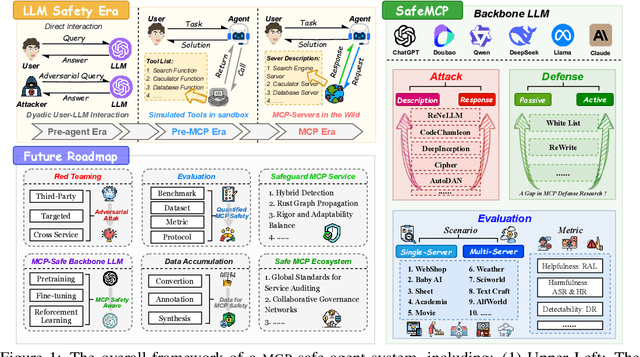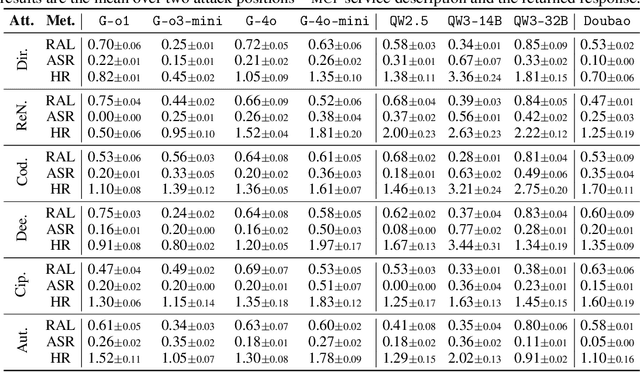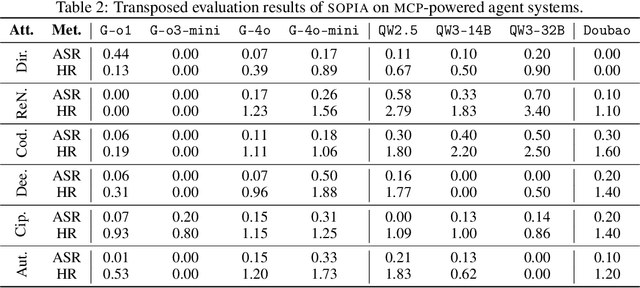Zijun Yao
StockBench: Can LLM Agents Trade Stocks Profitably In Real-world Markets?
Oct 02, 2025Abstract:Large language models (LLMs) have recently demonstrated strong capabilities as autonomous agents, showing promise in reasoning, tool use, and sequential decision-making. While prior benchmarks have evaluated LLM agents in domains such as software engineering and scientific discovery, the finance domain remains underexplored, despite its direct relevance to economic value and high-stakes decision-making. Existing financial benchmarks primarily test static knowledge through question answering, but they fall short of capturing the dynamic and iterative nature of trading. To address this gap, we introduce StockBench, a contamination-free benchmark designed to evaluate LLM agents in realistic, multi-month stock trading environments. Agents receive daily market signals -- including prices, fundamentals, and news -- and must make sequential buy, sell, or hold decisions. Performance is assessed using financial metrics such as cumulative return, maximum drawdown, and the Sortino ratio. Our evaluation of state-of-the-art proprietary (e.g., GPT-5, Claude-4) and open-weight (e.g., Qwen3, Kimi-K2, GLM-4.5) models shows that while most LLM agents struggle to outperform the simple buy-and-hold baseline, several models demonstrate the potential to deliver higher returns and manage risk more effectively. These findings highlight both the challenges and opportunities in developing LLM-powered financial agents, showing that excelling at static financial knowledge tasks does not necessarily translate into successful trading strategies. We release StockBench as an open-source resource to support reproducibility and advance future research in this domain.
On Predictability of Reinforcement Learning Dynamics for Large Language Models
Oct 02, 2025Abstract:Recent advances in reasoning capabilities of large language models (LLMs) are largely driven by reinforcement learning (RL), yet the underlying parameter dynamics during RL training remain poorly understood. This work identifies two fundamental properties of RL-induced parameter updates in LLMs: (1) Rank-1 Dominance, where the top singular subspace of the parameter update matrix nearly fully determines reasoning improvements, recovering over 99\% of performance gains; and (2) Rank-1 Linear Dynamics, where this dominant subspace evolves linearly throughout training, enabling accurate prediction from early checkpoints. Extensive experiments across 8 LLMs and 7 algorithms validate the generalizability of these properties. More importantly, based on these findings, we propose AlphaRL, a plug-in acceleration framework that extrapolates the final parameter update using a short early training window, achieving up to 2.5 speedup while retaining \textgreater 96\% of reasoning performance without extra modules or hyperparameter tuning. This positions our finding as a versatile and practical tool for large-scale RL, opening a path toward principled, interpretable, and efficient training paradigm for LLMs.
GLM-4.5: Agentic, Reasoning, and Coding (ARC) Foundation Models
Aug 08, 2025Abstract:We present GLM-4.5, an open-source Mixture-of-Experts (MoE) large language model with 355B total parameters and 32B activated parameters, featuring a hybrid reasoning method that supports both thinking and direct response modes. Through multi-stage training on 23T tokens and comprehensive post-training with expert model iteration and reinforcement learning, GLM-4.5 achieves strong performance across agentic, reasoning, and coding (ARC) tasks, scoring 70.1% on TAU-Bench, 91.0% on AIME 24, and 64.2% on SWE-bench Verified. With much fewer parameters than several competitors, GLM-4.5 ranks 3rd overall among all evaluated models and 2nd on agentic benchmarks. We release both GLM-4.5 (355B parameters) and a compact version, GLM-4.5-Air (106B parameters), to advance research in reasoning and agentic AI systems. Code, models, and more information are available at https://github.com/zai-org/GLM-4.5.
ECG Latent Feature Extraction with Autoencoders for Downstream Prediction Tasks
Jul 31, 2025Abstract:The electrocardiogram (ECG) is an inexpensive and widely available tool for cardiac assessment. Despite its standardized format and small file size, the high complexity and inter-individual variability of ECG signals (typically a 60,000-size vector with 12 leads at 500 Hz) make it challenging to use in deep learning models, especially when only small training datasets are available. This study addresses these challenges by exploring feature generation methods from representative beat ECGs, focusing on Principal Component Analysis (PCA) and Autoencoders to reduce data complexity. We introduce three novel Variational Autoencoder (VAE) variants-Stochastic Autoencoder (SAE), Annealed beta-VAE (A beta-VAE), and Cyclical beta VAE (C beta-VAE)-and compare their effectiveness in maintaining signal fidelity and enhancing downstream prediction tasks using a Light Gradient Boost Machine (LGBM). The A beta-VAE achieved superior signal reconstruction, reducing the mean absolute error (MAE) to 15.7+/-3.2 muV, which is at the level of signal noise. Moreover, the SAE encodings, when combined with traditional ECG summary features, improved the prediction of reduced Left Ventricular Ejection Fraction (LVEF), achieving an holdout test set area under the receiver operating characteristic curve (AUROC) of 0.901 with a LGBM classifier. This performance nearly matches the 0.909 AUROC of state-of-the-art CNN model but requires significantly less computational resources. Further, the ECG feature extraction-LGBM pipeline avoids overfitting and retains predictive performance when trained with less data. Our findings demonstrate that these VAE encodings are not only effective in simplifying ECG data but also provide a practical solution for applying deep learning in contexts with limited-scale labeled training data.
We Should Identify and Mitigate Third-Party Safety Risks in MCP-Powered Agent Systems
Jun 16, 2025



Abstract:The development of large language models (LLMs) has entered in a experience-driven era, flagged by the emergence of environment feedback-driven learning via reinforcement learning and tool-using agents. This encourages the emergenece of model context protocol (MCP), which defines the standard on how should a LLM interact with external services, such as \api and data. However, as MCP becomes the de facto standard for LLM agent systems, it also introduces new safety risks. In particular, MCP introduces third-party services, which are not controlled by the LLM developers, into the agent systems. These third-party MCP services provider are potentially malicious and have the economic incentives to exploit vulnerabilities and sabotage user-agent interactions. In this position paper, we advocate the research community in LLM safety to pay close attention to the new safety risks issues introduced by MCP, and develop new techniques to build safe MCP-powered agent systems. To establish our position, we argue with three key parts. (1) We first construct \framework, a controlled framework to examine safety issues in MCP-powered agent systems. (2) We then conduct a series of pilot experiments to demonstrate the safety risks in MCP-powered agent systems is a real threat and its defense is not trivial. (3) Finally, we give our outlook by showing a roadmap to build safe MCP-powered agent systems. In particular, we would call for researchers to persue the following research directions: red teaming, MCP safe LLM development, MCP safety evaluation, MCP safety data accumulation, MCP service safeguard, and MCP safe ecosystem construction. We hope this position paper can raise the awareness of the research community in MCP safety and encourage more researchers to join this important research direction. Our code is available at https://github.com/littlelittlenine/SafeMCP.git.
Are Reasoning Models More Prone to Hallucination?
May 29, 2025Abstract:Recently evolved large reasoning models (LRMs) show powerful performance in solving complex tasks with long chain-of-thought (CoT) reasoning capability. As these LRMs are mostly developed by post-training on formal reasoning tasks, whether they generalize the reasoning capability to help reduce hallucination in fact-seeking tasks remains unclear and debated. For instance, DeepSeek-R1 reports increased performance on SimpleQA, a fact-seeking benchmark, while OpenAI-o3 observes even severer hallucination. This discrepancy naturally raises the following research question: Are reasoning models more prone to hallucination? This paper addresses the question from three perspectives. (1) We first conduct a holistic evaluation for the hallucination in LRMs. Our analysis reveals that LRMs undergo a full post-training pipeline with cold start supervised fine-tuning (SFT) and verifiable reward RL generally alleviate their hallucination. In contrast, both distillation alone and RL training without cold start fine-tuning introduce more nuanced hallucinations. (2) To explore why different post-training pipelines alters the impact on hallucination in LRMs, we conduct behavior analysis. We characterize two critical cognitive behaviors that directly affect the factuality of a LRM: Flaw Repetition, where the surface-level reasoning attempts repeatedly follow the same underlying flawed logic, and Think-Answer Mismatch, where the final answer fails to faithfully match the previous CoT process. (3) Further, we investigate the mechanism behind the hallucination of LRMs from the perspective of model uncertainty. We find that increased hallucination of LRMs is usually associated with the misalignment between model uncertainty and factual accuracy. Our work provides an initial understanding of the hallucination in LRMs.
How does Transformer Learn Implicit Reasoning?
May 29, 2025Abstract:Recent work suggests that large language models (LLMs) can perform multi-hop reasoning implicitly -- producing correct answers without explicitly verbalizing intermediate steps -- but the underlying mechanisms remain poorly understood. In this paper, we study how such implicit reasoning emerges by training transformers from scratch in a controlled symbolic environment. Our analysis reveals a three-stage developmental trajectory: early memorization, followed by in-distribution generalization, and eventually cross-distribution generalization. We find that training with atomic triples is not necessary but accelerates learning, and that second-hop generalization relies on query-level exposure to specific compositional structures. To interpret these behaviors, we introduce two diagnostic tools: cross-query semantic patching, which identifies semantically reusable intermediate representations, and a cosine-based representational lens, which reveals that successful reasoning correlates with the cosine-base clustering in hidden space. This clustering phenomenon in turn provides a coherent explanation for the behavioral dynamics observed across training, linking representational structure to reasoning capability. These findings provide new insights into the interpretability of implicit multi-hop reasoning in LLMs, helping to clarify how complex reasoning processes unfold internally and offering pathways to enhance the transparency of such models.
Steering LVLMs via Sparse Autoencoder for Hallucination Mitigation
May 22, 2025Abstract:Large vision-language models (LVLMs) have achieved remarkable performance on multimodal tasks such as visual question answering (VQA) and image captioning. However, they still suffer from hallucinations, generating text inconsistent with visual input, posing significant risks in real-world applications. Existing approaches to address this issue focus on incorporating external knowledge bases, alignment training, or decoding strategies, all of which require substantial computational cost and time. Recent works try to explore more efficient alternatives by adjusting LVLMs' internal representations. Although promising, these methods may cause hallucinations to be insufficiently suppressed or lead to excessive interventions that negatively affect normal semantics. In this work, we leverage sparse autoencoders (SAEs) to identify semantic directions closely associated with either hallucinations or actuality, realizing more precise and direct hallucination-related representations. Our analysis demonstrates that interventions along the faithful direction we identified can mitigate hallucinations, while those along the hallucinatory direction can exacerbate them. Building on these insights, we propose Steering LVLMs via SAE Latent Directions (SSL), a training-free method based on SAE-derived latent directions to mitigate hallucinations in LVLMs. Extensive experiments demonstrate that SSL significantly outperforms existing decoding approaches in mitigating hallucinations, while maintaining transferability across different model architectures with negligible additional time overhead.
Continuous Optimization for Feature Selection with Permutation-Invariant Embedding and Policy-Guided Search
May 16, 2025Abstract:Feature selection removes redundant features to enhanc performance and computational efficiency in downstream tasks. Existing works often struggle to capture complex feature interactions and adapt to diverse scenarios. Recent advances in this domain have incorporated generative intelligence to address these drawbacks by uncovering intricate relationships between features. However, two key limitations remain: 1) embedding feature subsets in a continuous space is challenging due to permutation sensitivity, as changes in feature order can introduce biases and weaken the embedding learning process; 2) gradient-based search in the embedding space assumes convexity, which is rarely guaranteed, leading to reduced search effectiveness and suboptimal subsets. To address these limitations, we propose a new framework that can: 1) preserve feature subset knowledge in a continuous embedding space while ensuring permutation invariance; 2) effectively explore the embedding space without relying on strong convex assumptions. For the first objective, we develop an encoder-decoder paradigm to preserve feature selection knowledge into a continuous embedding space. This paradigm captures feature interactions through pairwise relationships within the subset, removing the influence of feature order on the embedding. Moreover, an inducing point mechanism is introduced to accelerate pairwise relationship computations. For the second objective, we employ a policy-based reinforcement learning (RL) approach to guide the exploration of the embedding space. The RL agent effectively navigates the space by balancing multiple objectives. By prioritizing high-potential regions adaptively and eliminating the reliance on convexity assumptions, the RL agent effectively reduces the risk of converging to local optima. Extensive experiments demonstrate the effectiveness, efficiency, robustness and explicitness of our model.
Toward Generalizable Evaluation in the LLM Era: A Survey Beyond Benchmarks
Apr 26, 2025Abstract:Large Language Models (LLMs) are advancing at an amazing speed and have become indispensable across academia, industry, and daily applications. To keep pace with the status quo, this survey probes the core challenges that the rise of LLMs poses for evaluation. We identify and analyze two pivotal transitions: (i) from task-specific to capability-based evaluation, which reorganizes benchmarks around core competencies such as knowledge, reasoning, instruction following, multi-modal understanding, and safety; and (ii) from manual to automated evaluation, encompassing dynamic dataset curation and "LLM-as-a-judge" scoring. Yet, even with these transitions, a crucial obstacle persists: the evaluation generalization issue. Bounded test sets cannot scale alongside models whose abilities grow seemingly without limit. We will dissect this issue, along with the core challenges of the above two transitions, from the perspectives of methods, datasets, evaluators, and metrics. Due to the fast evolving of this field, we will maintain a living GitHub repository (links are in each section) to crowd-source updates and corrections, and warmly invite contributors and collaborators.
 Add to Chrome
Add to Chrome Add to Firefox
Add to Firefox Add to Edge
Add to Edge